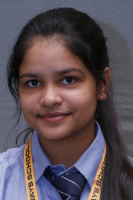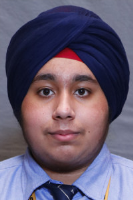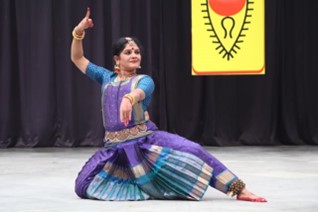
Nilay Jain
PYP 5

Nilay Jain
PYP 5

Saanvi Sehgal
PYP 5

Arush Nath
MYP 4

Arjun Sabherwal
MYP 4

Diya Mehra
MYP 4

Arav Agarwal
MYP 5

Arhan Singhal
MYP 5

Aanya Tulsyan
DPCP 1

Oshwin Dang
DPCP 1

Abhyuthan Srivastava
DPCP 1

Yashraj Garg
DPCP 1

Nilay Jain
PYP 5

Saanvi Sehgal
PYP 5

Arush Nath
MYP 4

Arjun Sabherwal
MYP 4

Diya Mehra
MYP 4

Arav Agarwal
MYP 5

Arhan Singhal
MYP 5

Aanya Tulsyan
DPCP 1

Oshwin Dang
DPCP 1

Abhyuthan Srivastava
DPCP 1

Yashraj Garg
DPCP 1
Today, we had the incredible opportunity to attend a Spic Macay session, which featured a Bharatanatyam performance by Ms. Ragini Chandershekar. With her 44 years of experience as a Bharatanatyam dancer, choreographer, and teacher, Ms. Ragini's performance was an example of a lifetime devoted to the art form.
One of the most fascinating aspects of the session was learning about the history and significance of Bharatanatyam. Ms. Ragini explained that this form of dance is almost 2,000 years old and is thought to have been taught to the renowned guru Bharata by Lord Brahma, who then wrote it down in the Natya Shastra. Learning about this made me appreciate the dance form for its cultural and historical roots even more. We learned that the use of hasta mudras (hand gestures) and body postures in Bharatanatyam improves overall body flexibility, while facial expressions play a vital role in conveying emotions and narratives. Ms. Ragini explained to us how Bharatanatyam was a form of Nritya Seva, where deities were worshipped through dance, particularly in southern India. Therefore, the language used in the compositions of this dance form is usually in Tamil, Telugu, Malayalam, and Sanskrit. She explained that Surdas Ji was an ardent devotee of Lord Krishna, and much of his poetry was based on the Baal Leelas of Krishna, including tales of him playing with his friends and stealing butter. Alongside, there was a parallel aspect of Krishna where he was depicted as the creator of the universe, completely oblivious to his identity as the supreme creator.
Ms. Ragini's background in music and dance and her personal connection to Bharatanatyam really stood out to me. Her mother was a well-known singer and dancer of Bharatanatyam, and had a major influence on her childhood, helping her develop a strong passion for the art form. She talked about the immersed environment that she was lucky to be born into and told us about the exciting and enriching experience of learning Bharatanatyam as a child. This provided a heartfelt touch to her performance, as I could sense her passion and commitment to Bharatanatyam. She told us how she compares Bharatanatyam to ‘old wine’, mellowed and simmered for years in barrels full of literature, poetry, music, and more, which helped me realize that classical dance forms like Bharatanatyam are far more than just a dance; they are like an ocean of cultural heritage and artistic expression that reflects India's rich tapestry of history and culture. Ms. Ragini highlighted that Indian classical dance forms do not merely follow contemporary trends; rather, they ARE the trends.
The performances themselves were mesmerizing. Each one shared with us a different story from Hindu mythology and included intricate movements and expressions. Ms. Ragini’s explanations of each dance's background and significance helped me appreciate them even more, as I gained insights into the cultural and historical contexts of these stories. As I sat in the audience, I was fascinated by the grace of her movements, and I was able to see these ancient stories and emotions come to life through her dance. The accompanying artists, including Gayatri Seth (Nattuvangam), K. Venkateshwaran (vocal), M.V, Chander Shekhan (Mridangam), and Rohit Prasanna (Flute), added depth and richness to the performance and helped make the entire performance a memorable experience for all of us.
During the Spic Macay session, Ms. Ragini Chandershekar performed four beautiful Bharatanatyam dances. The first performance depicted the stories of Shiva and Krishna, showcasing the different poses and movements associated with each deity. Ms. Ragini explained the significance of these poses, such as Krishna dancing in the river Yamuna and Shiva's half-moon adornment, which helped us understand the divine aspects of these characters. The second performance focused on Lakshmi, the wife of Shiva, showcasing her grace and beauty through Ms. Ragini’s elegant movements. The third performance depicted a scene where one of the Gopis comes running to Yashoda, informing her about Krishna's mischievous activities. The fourth and final performance was a story of Radha and Krishna, which Ms. Ragini believed had a feminist side to it. She explained that while Krishna usually leads in their interactions, in this story, Radha took the lead, showing us the dynamic nature of their relationship.
Throughout the performances, Ms. Ragini emphasized the importance of body and facial movements in Bharatanatyam and explained how these elements actually help convey the emotions and the essence of the stories being told. We also learned about the different variations and syllables that are strung to music and rhythm to give shape and framework to the musical composition. Ms. Ragini's explanations of the background stories of each dance helped us understand the performances better, providing insights into cultural and historical aspects of Indian heritage.
Furthermore, Ms. Ragini explained to us the meaning behind the SPIC MACAY logo, which represents the third eye of wisdom and inquiry. This symbolizes the organization's aim to give younger generations an opportunity to open their inner eye by experiencing the timeless aspects of Indian heritage. The origin of the "third eye" logo from a symbolic story in the Mahabharata provided a philosophical dimension to the session as well. We were amazed to learn that some of the performances were impromptu and spontaneously done, with Ms. Ragini and her vocalists improvising on the spot. This displayed their incredible talent and depicted the spontaneity and creativity of Bharatanatyam.
The session concluded with an interactive Q&A session, where students and teachers got the chance to ask questions. Ms. Ragini talked about how Bharatanatyam is a unique dance discipline that takes years to master, showing how humble and dedicated she was. She highlighted the lifelong learning and development that comes with being a dancer and shared that even after 44 years of training, she still feels that she has not mastered the art form entirely. When we asked about her accomplishments, she shared that for her, each time she goes up on stage and communicates with the audience through her dance, making them understand what she wants to convey, it is a huge accomplishment.
Overall, the SPIC MACAY event was an unforgettable experience for me. Besides expanding my knowledge of Indian classical dance and culture, it also made me appreciate performers like Ms. Ragini Chandershekar, who have devoted their entire lives to preserving and promoting this ancient dance form. I am thankful for this opportunity to gain a greater understanding of Indian traditional dance and culture, and it was truly an honor to attend such a beautiful and symbolic performance.
By: Alia Rathi, MYP 4F

Consistently ranked #1 Best International School in Gurgaon, Delhi, Faridabad - Education World C Fore Survey
 Baliawas Off Gurugram Faridabad Road, Gurugram – 122003
Baliawas Off Gurugram Faridabad Road, Gurugram – 122003 [email protected]
[email protected]Drop us your details for a quick response.
Copyright 2023 © Pathways School Gurgaon. All rights reserved.
Design and Development by Sterco Digitex